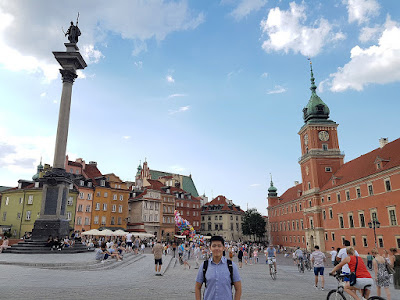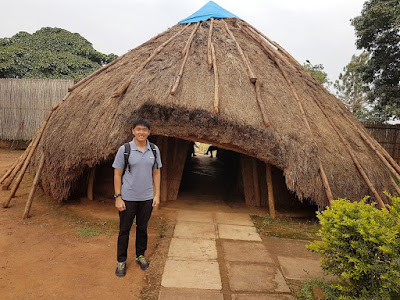Warsaw, Poland
The history of Warsaw Old Town dates back to the 13th century. The charming area has been included in the list of UNESCO World Heritage Sites since 1980 as "an outstanding example of a near-total reconstruction of a span of history covering the 13th to the 20th century".
My BFF and I entered the old town from its eastern end as we walked from Centrum Nauki Kopernik metro station along the road next to Vistula River.
 |
| Warsaw is called Varsovia in Latin and Spanish. |
 |
| "Used to say I like Chopin~ Love me now and again~" |
After ascending the slope, we reached an open area where we started seeing lots and lots of tourists.
 |
| A taste of pierogi (Polish dumplings), anyone? |
In a separate post, I wrote about
St. Anne's Church.
 |
| I didn't know earlier that it's possible to ascend the bell tower for a small fee. |
One can't miss the sight of the towering Sigismund's Column. King Sigismund III Vasa was the one who moved Poland's capital from Krakow to Warsaw in 1596.
 |
| The column is 22 m high. |
Facing the column is the Royal Castle that was originally completed in 1619. However, it was almost completely destroyed in 1944 following the Warsaw Uprising, but it was successfully reconstructed from 1971 to 1984.
We didn't enter the castle. Take note that it's closed to the public on Monday throughout the year.
 |
| Lovely brick red colour~ |
Fancy exploring the old town on a horse-drawn carriage?
 |
| Shiny black horse! |
We were pretty much walking aimlessly, getting ourselves absorbed in the lively atmosphere.
 |
| The bronze Wishing Well of Warsaw was made in 1646. |
The bustling Old Town Market Place was blown up by the Germans immediately after the Warsaw Uprising, but it was restored to its pre-war appearance after World War II.
 |
| I actually wanted to take a photo of Melon pretending to be a basilisk. |
Not much greenery in the photos above, eh? Let's head to the north.
 |
| I hope my face doesn't ruin the beauty of the surroundings. |
At the northern end of the old town is the Warsaw Barbican, one of the few remaining parts of the fortification system that once encircled the town.
 |
| For the uninitiated, a barbican is a semi-circular fortified outpost. |
 |
| Beautiful paintings for sale! |
To think that over 85% of the buildings in Warsaw were destroyed by the end of World War II, I was certainly in awe at the successful restoration of the old town.
 |
| I really miss Georgian cuisine! |
There are certainly many other things to see in the old town, such as historical landmarks and museums, that I don't cover in this post. The Museum of Warsaw, for one, offers guests the opportunity to walk through medieval basements. Go and see for yourself!
















































































Comments
Post a Comment